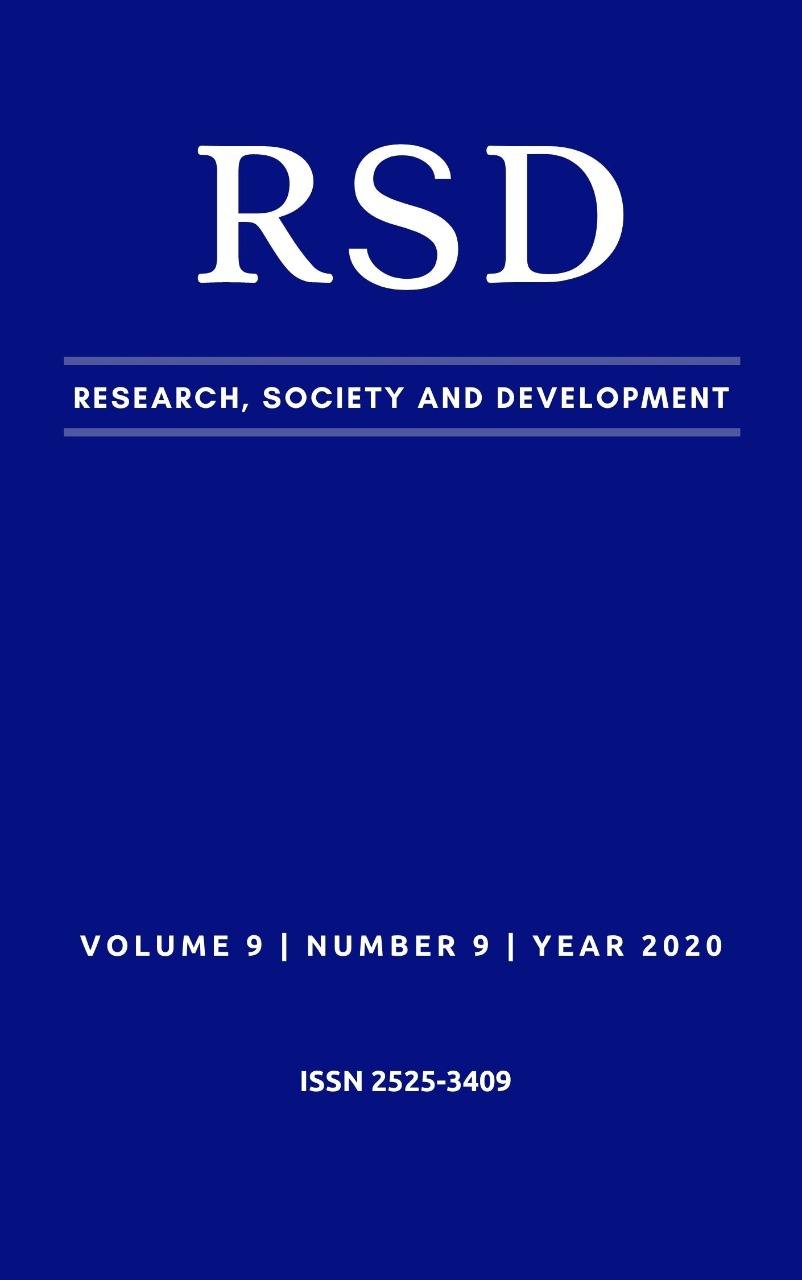Óleo vegetal na dieta de equinos submetidos a exercício
DOI:
https://doi.org/10.33448/rsd-v9i9.7444Palavras-chave:
Aveia, Colesterol, Parâmetros séricos, Parâmetros fisiológicos.Resumo
Objetivou-se e avaliar os efeitos da adição de óleo de soja nos parâmetros séricos e fisiológicos de equinos submetidos a exercício físico. Foram utilizadas 6 éguas da raça Crioula, com idade de quatro anos, e peso aproximado de 350 kg. Os tratamentos foram: Controle 5 kg de MS de aveia (Avena sativa) e 5 kg de MS de Capim Aruana (Panicum Jacq., cv. Aruana); Tratado: 3,52 kg de aveia (Avena sativa), 5 kg de MS de Capim Aruana (Panicum Jacq., cv. Aruana) e 500 g de óleo de soja. Foram efetuadas pesagens e coleta de sangue, no dia 0, 14 e 28 dias de experimento em jejum para análise dos parâmetros séricos. Aos 28 dias de experimentação os equinos foram submetidos a exercício, durante 30 minutos. Antes do início foram realizadas coletas, em jejum, pela manhã e imediatamente após o exercício, 10 minutos e 3 horas após o fim do exercício, além de aferir os parâmetros fisiológicos antes e logo após o exercício. Os valores apresentaram diferença significativa (P<0,05) para colesterol total, HDL, LDL, VLDL e triglicerídeo aos 14 dias de experimento, aos 28 dias diferença apenas para (P<0,05) colesterol total e LDL. Com a realização do exercício não houve diferença nos parâmetros séricos, mas observou-se diferença para os parâmetros fisiológicos entre os períodos de coleta. A adição de óleo de soja na dieta de equinos submetidos a exercício não interfere os parâmetros séricos, tornando-se assim uma alternativa para dietas energéticas.
Referências
Binda, M. B., Teixeira, F. A., Carvalho, R. S., Macedo, L. P., Conti, L. M. C., Filho, H. C. M. (2016). Effects of 3-Barrel Racing Exercise on Electrocardiographic and on Blood Parameters of Quarter Horses. Journal Equine Veterinary Science, 47, 71-76.
Cintra, A. G. (2016). Alimentação equina: nutrição, saúde e bem-estar. Rio de Janeiro: Roca.
Frape, D. L. (1994). Diet and exercise performance in the horse. Proceedings of the Nutrition Society, 53, 189-206.
Gomes, C. L. N., Ribeiro Filho, J. D., Silva, L. P., Aranha R. M. C., Moraes Jr., F. J., Cardoso, J. K. M., & Monteiro, L. C. (2019). Arquivo Brasileiro Medicina Veterinária e Zootecnia, 71 (2), 631-639.
Hallebeek, J. M. (2002). Dietary control of equine plasma triacylglycerols. 140f. Thesis (Doctor in Animal Nutritiol) - Universiteit Utrecht, Utrecht.
Hurley, B. F., Nemeth, P. M., Martin Iii, W. H., Hagberg, J. M., Dalsky, G. P., & Holloszy, J. O. (1986). Muscle triglyceride utilization during exercise: effect of training. Journal Applied Physiology, 60, 562-567.
Kaneko, J. J., Harvey, J. W., & Bruss, M. L. (Eds.). (1997). Clinical biochemistry of domestic animals. (5th ed.), New York: Academic Press.
Marchello, E. V., Schurg, W. A., Marchello, J. A., & Cuneo, P. (2000). Changes in lipoprotein composition in horses fed a fat-supplemented diet. Journal Equine Veterinary Science, 20, 453-458.
Marqueze, A., Kesller, A. M., & Bernardi, M. L. (2018). Aumento do nível de óleo em dietas isoenergéticas para cavalos submetidos a exercício. Ciência Rural, 31 (3), 491-496.
Mattos, F., Araujo, K. V., Leite, G. G., & Goulart, H. M. (2006). Uso de óleo na dieta de equinos submetidos ao exercício. Revista Brasileira de Zootecnia, 35 (4), 1373-1380.
Meyers, M. C., Potter, G. D., Evans, J. W., & Greene, L. W. (1989). Physiologic and metabolic response of exercising horses to added dietary fat. Journal Equine Veterinary Science, 9 (4), 218-223.
National Research Council - NRC. (1989). Nutrient requirements of horses. (5a ed.), rev. Washington, D. C.: National Academy Press.
Padilha, F. G. F., Dimache, L. A. G., Almeida, F. Q., & Ferreira, A. M. R. (2017). Blood biochemical parameters of Brazilian sport horses under training in tropical climate. Revista Brasileira de Zootecnia, 6, 678-682.
Pereira, A. S., Shitsuka, D. M., Parreira, F. J., & Shitsuka, R. (2018). Metodologia da pesquisa científica. [e-book]. Santa Maria. Ed. UAB/NTE/UFSM. Recuperado de https://repositorio.ufsm.br/bitstream/handle/1/15824/Lic_Computacao_Metodologia-Pesquisa-Cientifica.pdf?sequence=1.
Resende, Jr. T., Rezende, A. S. C., Lacerda, O. V. Jr., Bretas, M., Lana, A., Moura, R. S., & Resende, H. C. (2004). Efeito do nível de óleo de milho adicionado à dieta de eqüinos sobre a digestibilidade dos nutrientes. Arquivo Brasileiro de Medicina Veterinária e Zootecnia, 56 (1), 69-73.
Scott, B. D., Potter, G. D., Greene, L. W., Hargis, E. S., & Anderson. J. G. (1992). Efficacy of a fat-supplemented diet on muscle glycogen concentration in exercising thoroughbred horses maintained in varying body conditions. Journal Equine Veterinary Science, 2 (2), 109-113.
Silva, V. P., Almeida, F. Q., Morgado, E. S., França, A. B., Ventura, H. T., & Rodrigues, L. M. (2009). Digestibilidade dos nutrientes de alimentos volumosos determinada pela técnica dos sacos móveis em equinos. Revista Brasileira de Zootecnia, 38 (1), 82-89.
Downloads
Publicado
Edição
Seção
Licença
Copyright (c) 2020 André Eduardo Mello Cerbaro; Rodolfo Noal Gonçalves; Jaqueline Schneider Lemes; Magda Pierezan; Vinícius Leobet Lunkes; Ricardo Zambarda Vaz

Este trabalho está licenciado sob uma licença Creative Commons Attribution 4.0 International License.
Autores que publicam nesta revista concordam com os seguintes termos:
1) Autores mantém os direitos autorais e concedem à revista o direito de primeira publicação, com o trabalho simultaneamente licenciado sob a Licença Creative Commons Attribution que permite o compartilhamento do trabalho com reconhecimento da autoria e publicação inicial nesta revista.
2) Autores têm autorização para assumir contratos adicionais separadamente, para distribuição não-exclusiva da versão do trabalho publicada nesta revista (ex.: publicar em repositório institucional ou como capítulo de livro), com reconhecimento de autoria e publicação inicial nesta revista.
3) Autores têm permissão e são estimulados a publicar e distribuir seu trabalho online (ex.: em repositórios institucionais ou na sua página pessoal) a qualquer ponto antes ou durante o processo editorial, já que isso pode gerar alterações produtivas, bem como aumentar o impacto e a citação do trabalho publicado.


